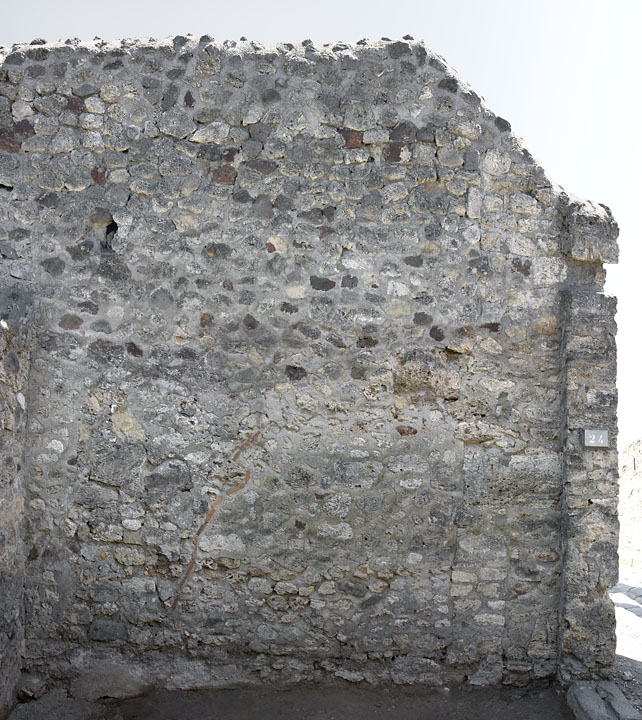South Wall
Description
A. Karivieri & R. Forsell
The wall is located between 24a and taberna 25 and has an east-west direction
There are remains of wall-plaster on the lower part of the wall.
Description:
The wall is built in opus incertum and by the entrance opus quadratum. The wall consists mostly of rounded limestone and some cruma. By the entrance there is a section, 0.40m wide, that consists of larger limestone blocks, and further to the east it is followed by another section, 0.40 m wide and 0.80 m high, constructed with alternating limestone and bricks. This part is corresponding with the west wall of taberna 25. Above this part, the wall is built of rounded limestone and some cruma. In the centre of the wall, 0.90 m from the southeast corner at the height of 2.05, there is a line of tiles indicating a modern repair made in the lower central part of the wall stretching to the transverse wall in opus quadratum by the entrance. Above this reconstructed part the wall is built in limestone, cruma, lava and yellow tuff, all rounded stones. This part of the wall bulges inwards. In the southeast corner the wall includes even larger blocks of limestone, grey tuff, "red tuff" and yellow tuff. Patches of yellow mortar are visible at the height of 1.90 m. In the upper part where the wall bulges, there is a clear protruding part above the height of 2.0 m. Below the reconstruction in the central part of the wall the original wall-structure seems to be preserved up to 0.27-0.28 m height.
Wall-plaster:
Wall-plaster is preserved on the lower part of the wall, in the southeast corner, in a section starting at 0.40 m from the corner and continuing in a 1.40 m long and 0.33 m high patch. In the southeast corner the wall-plaster continues below the level of the cocciopesto floor by the pozzo in the corner. Ca 1.0 m from the southeast corner, above the latest floor in the room, there is a patch of wall-plaster, 8 cm wide. Behind it there is another layer of wall-plaster, possibly white or yellow, and behind these two a third layer of white plaster, which is also preserved in the wall of the pozzo, continues below the floor level. Nearest to the corner, there is a possible fourth, white plaster layer behind the third layer.
Interpretation: The wall is heavily reconstructed. The pozzo with the amphorae can be connected with the white plaster layer visible in the lower part of the south wall in the southeast corner.
Observation:
A hole, with plaster on its western side, located in the upper part of the wall in the southeast corner, above the pozzo, indicates a possible square beam hole.
Dimensions: l. 4.02m.

